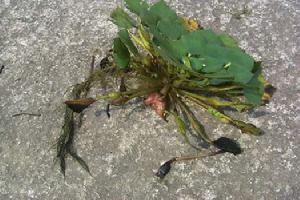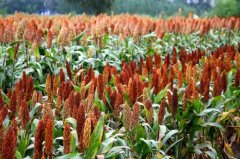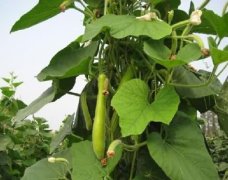What is a water chestnut? How is water chestnut cultivated? how to grow water chestnut in deep water
The water chestnut planting site chooses the water chestnut, which belongs to the rhombus family, and is an annual aquatic crop. It is suitable for survival in high-temperature and humid swamps or paddy fields. How exactly is it planted? Let's get to know it and try to plant it yourself.
Water chestnut planting site selection: it can be planted in marsh ponds or paddy fields with a low-lying water depth of about 15-60 cm in the tropics. The fertile loam with a temperature of 25 ℃ ~ 36 ℃ and a pH value of 5.6-6.8 is the most suitable for the growth of water chestnut, and the water chestnut grown with living water is the most delicious. The main varieties are divided into two systems: obtuse angle short thorn and acute angle long thorn.
Water chestnut seed-remaining seed: water chestnut is collected and cultivated, which needs to be sown with seed every year. The demand for seed per unit area is large, which needs 50.7 kg water chestnut per 0.1 hectare. The selection of fine water chestnut seeds for seed retention will be related to the quality and yield of water chestnut in the coming year. When the fruit is fully ripe, the germination rate is high, large, complete and full is the most important point of water chestnut seed retention, it is best to select the appropriate proportion of salt water (about 1.2), leave water chestnut, and then select the shape of water chestnut. If the number of seeds left is small, experienced farmers often choose seeds to stay at the end of harvest.

Sowing and raising seedlings of water chestnut, put the selected high-quality ripe water chestnut into the water of the rhombic field, and wait for it to germinate, the germination hole will grow into Hypocotyl, then grow into stem, grow upward, float out of the water surface and grow leaves, and the method of plant division can also be adopted. The fine seeds selected from November to December of the year before last were placed in a large container that could store water, and the water was changed every 3-4 days to prevent decay, or stored in a net bag at the bottom of the pool where the water level could be maintained. Taiwan's natural low temperature period is short, and the low temperature demand for water chestnut seeds to break dormancy is not high. Water chestnut can sprout one after another in January and can be transplanted to a small shallow water nursery at about 5 cm. Attention should be paid to bamboo sticks as a mark to prevent the mixing of autogenous seedlings from water chestnuts last year.
Land preparation and planting in water chestnut field: after the last stage of rice harvest, it can be planted in a week after irrigation with a large tractor plough from late April to mid-May. The seedlings are multi-branched and clustered buds, which are tied into a bunch of 3-5 vines and then planted in the subsoil. 300 plants can be planted every 0.1 hectare. Except for those with poor soil fertility, there is no significant difference in the yield and quality of the whole period among different planting densities. The early yield of dense planting is higher, the early purchase price is higher, and the production is more favorable. In the past, it was thought that the high planting density was the main reason for the serious occurrence of anthracnose in recent years, but the experimental results showed that it had little effect on water chestnut.
Water chestnut field-after fertilization: the planting period of water chestnut is more than half a year, and the technology of fertilization has a deep effect on the yield and quality of water chestnut. Generally, 1000 kg of mature compost should be mixed with 1000 kg of mature compost per 0.1ha before ploughing. At the initial stage of planting, it is not suitable to apply more fertilizer to prevent the rapid growth of algae, and excessive vegetative growth will delay the harvest and reduce the flowering and fruiting of water chestnut, resulting in a decrease in yield. In front of the water surface, the water chestnut plant can be partially treated with urea to promote the vegetative growth of the plant until the density gradually enters the water chestnut harvest period, when the water chestnut plant bears most of the fruit. Compound fertilizer can be applied after each harvest (such as Taiwan fertilizer 43 8 kg). The water chestnut fruit will be much fuller than the rest.) Apply fertilizer at least six times, and then apply more at a later stage. Although it is also suggested to spray leaves with urea to facilitate the rapid absorption of nitrogen fertilizer, it should be noted that excessive application of nitrogen fertilizer is easy to be accompanied by serious anthracnose and reduce the quality of water chestnut.
Water source for irrigation in water chestnut field: in the initial stage of planting water chestnut, the water level should be kept low, and the plant should be in close contact with water chestnut, while the water depth of water chestnut in paddy field should be kept at 60 cm. If the water level is too shallow in summer, the water temperature is easy to rise rapidly, and the high water temperature can easily lead to insufficient dissolved oxygen in the water, hinder root respiration, and indirectly affect nutrient absorption and plant growth. In the later stage of plant growth, it is appropriate to keep the water level stable and less change. In areas where there is no shortage of water supply, the collection of living water for planting, or moderate change of water in the later stage of planting, will be beneficial to the improvement of yield and quality and prolong the harvest period.
- Prev

Sweet Sorghum planting Technology: what is Sweet Sorghum? There are some differences between sweet sorghum and sorghum.
Do you know sweet sorghum? Why is sweet sorghum called sweet sorghum? What's the difference between it and sorghum? let's take a look. Sweet sorghum is a variety of seed sorghum, which can produce 5000 to 6000 kilograms of seeds per hectare, but the seeds are smaller and weigh a thousand seeds.
- Next

What is a flat cattail? How to pick the heart and prune the bottle gourd
Flat cattail is also called bottle gourd. Flat cattail is a very popular vegetable. Do you know how it is grown? Do you want to know about it? 1. Cultivation season: although Prunus mandshurica can be cultivated all the year round in Taiwan, March-April in the north-central part and December-the following year in the south
Related
- The first cup of black tea in spring, the flavor and history of tea gardens in Kenya, Africa
- The computer can not only choose potatoes, but also grow tea rice. AI will grow winter oolong tea champion.
- It is not only the inflated tea bitten by insects, but also engraved with the four seasons tea in Beipu.
- The Oriental Beauty Tea Festival in Zhuxian County takes the stage at the weekend to experience the plus-size feast of oil tea.
- & quot; Oriental Beauty Tea & Exploration of Emei in Hsinchu, the hometown of quot;
- The new variety of strawberry "Tainong 1" dessert is the first choice with mellow aroma. Crimson gorgeous
- History of Tea in Taiwan: from Wild Inner Mountain to Export Tea Garden
- Two types of Taiwan Oriental Beauty Black Tea won the British three-Star Award for Childhood Tea Xiang Zhang Jiaqi changed from pilot to champion tea maker.
- Banana species and varieties: the planting history of Taiwan Xianren banana and dwarf banana is long, is banana disease resistant?
- Coffee planting Technology: Qianjie Coffee from Seedling to harvesting

